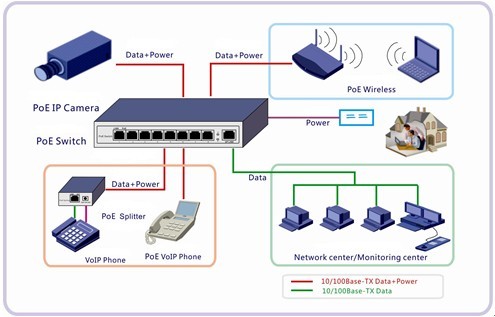How to distinguish between standard PoE switches and non-standard PoE switches?
2022/5/11 11:04:09
PoE technology has been developed for many years and is now at a very mature stage, and the standard PoE power supply is stable and safe enough. Most of the conditions are due to the selection of non-standard PoE switch (PoE injector) or wire quality is too poor, or the program design itself is not reasonable, the power supply distance is not arranged or connected to too many high-power devices appear power supply shortage (especially at night when the monitoring equipment open infrared irradiation mode). So in the actual deployment found in the case of unstable power supply to first investigate the external causes.
In layman's terms, POE switch is a switch that supports network cable power supply, which can not only realize the data transmission function of ordinary switches but also supply power to network terminals at the same time. So, how do we distinguish how to distinguish the standard POE switch and non-standard POE switch?
Firstly, you need to clarify the difference between a standard PoE switch and a non-standard PoE switch. The standard PoE-powered switch has a PoE control chip inside, which has a detection function before power supply. When the device is connected, the PoE supplier will send a signal to the network to detect whether the terminal in the network is a PD device supporting PoE power supply. This belongs to the "soft power", which can well maintain the safety and stability of PoE devices in the line.
The non-standard PoE product is a strong supply type network line power supply device, once the power is supplied, there is no detection step, regardless of whether the terminal is a PoE powered device are powered. Moreover, when there are other PoE-powered devices in the line, it is very easy to conflict, resulting in power fire and line failure.

Secondly, the POE switch classification
1、Standard POE switch
In line with IEEE802.3af, 802.3at standard, is the standard POE switch (commonly known as 48V), the complete POE including power supply terminal equipment (PSE, Power Sourcing Equipment) and powered terminal equipment (PD, Power Device) two parts, poe switch for a PSE device. The PSE is the device that supplies power to the terminal, and is also the manager of the POE Power over Ethernet process; the PD is the terminal device that receives power (48V national standard device contains PD chip).
2、Non-standard POE switch
On the contrary, it is non-standard POE switch ("non-standard" is called "non-standard", but non-standard has 48V, 24V, 12V, 5V, etc.).
Thirdly, POE switch mainstream applications
POE switch mainly provides network and power supply for monitoring (power supply for camera), wireless coverage (power supply for AP), wireless transmission (power supply for bridge) and other equipment.
Fourthly, the standard POE power supply switch work process
1, detection: poe switch first output a very small voltage, detection of the receiving end of the device containing a chip that supports the IEEE802.3at/af standard (support IEEE802.3at/af standard chip referred to as "PD").
2. PD classification: After PD is detected, the poe switch classifies the PD device and evaluates the power of the PD device.
3. Power supply: During the start-up period (generally less than 15μs), the poe switch supplies power to the PD from a low voltage until the voltage required by the PD is sufficient to provide stable and reliable DC power to the PD device.
4, power off: If the PD device is disconnected, the poe switch will quickly (generally within 300-400ms) stop supplying power to the PD, and repeat the detection process to detect whether the cable terminal is connected to the PD device.
Fifthly. Distinguish between standard PoE and non-standard PoE It is very simple, just use a multimeter to measure.
Start the device, set the multimeter to the voltage measurement gear, and use the two pens of the multimeter to touch the PSE device power supply feet (usually 1/2, 3/6 or 4/5, 7/8 of the RJ45 port), if the measured 48V or other voltage values (12V, 24V, etc.) stable output of the device that is non-standard products. Because in this process, PSE does not do testing on the powered equipment (here is a multimeter), and directly use 48V or other voltage values to supply power.
Conversely, if the voltage is not measured and the multimeter needle jumps between 2 and 10 V, it is a standard POE. because at this stage, the PSE is doing detection on the PD side (here is the multimeter), and the multimeter is not a legitimate PD, the PSE will not supply power, no stable voltage is generated.
Sixthly, PoE power supply switch power is the more the better?
Due to the emergence of high-power devices such as HD dome, real-time video telephony, network equipment manufacturers are scrambling to develop PoE switches with higher total power. However, many products only seek to increase the total power, ignoring the relationship between power and the number of ports. While the power is high, it will inevitably cause the overall cost of the device to increase, and the result is that the user chooses a PoE switch that is not very practical and has a low cost performance. So when choosing PoE powered devices and cables, be sure to strictly calculate the product power consumption and line loss, and not to increase the power output of the switch oriented.
More details, pls visit: http://www.htopto.com/en/acpzs.asp?dlb_id=12


